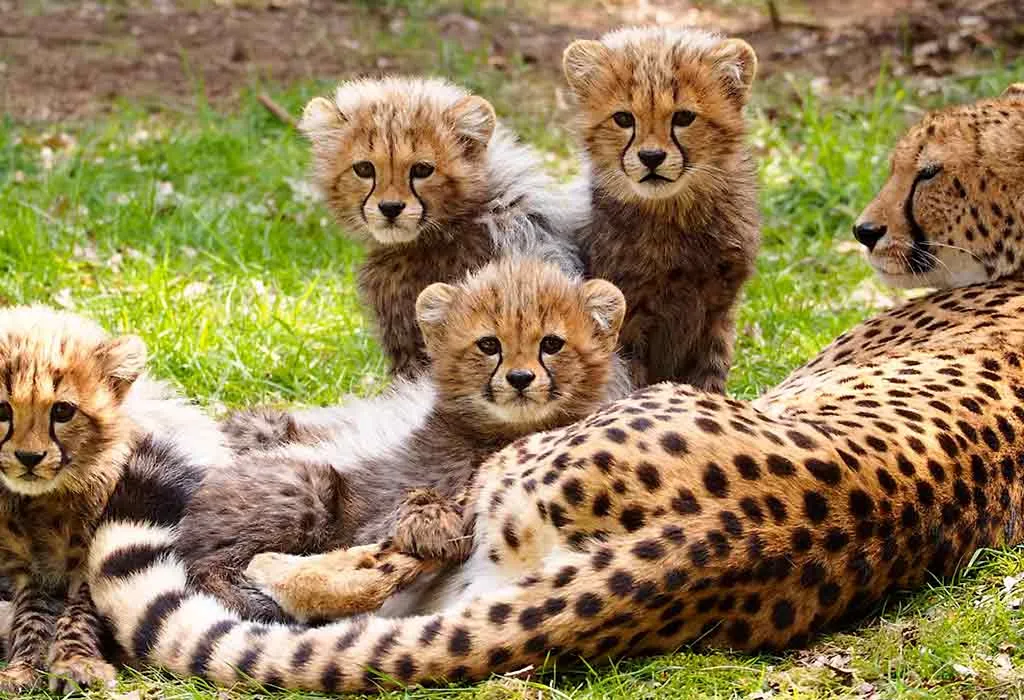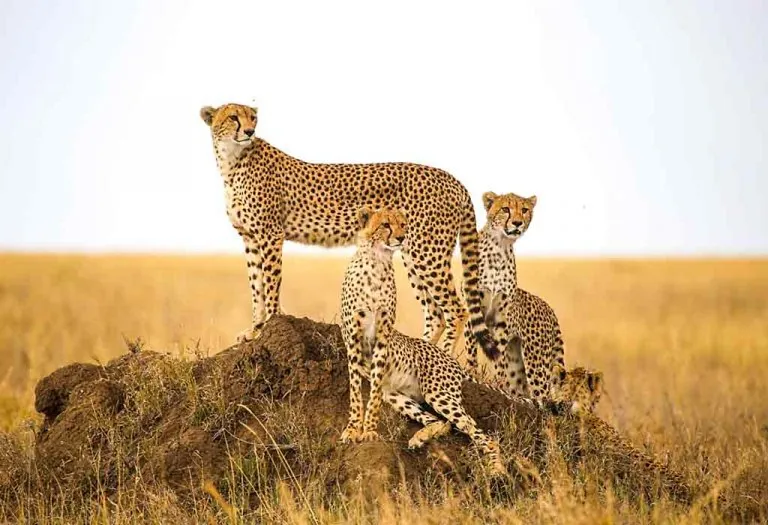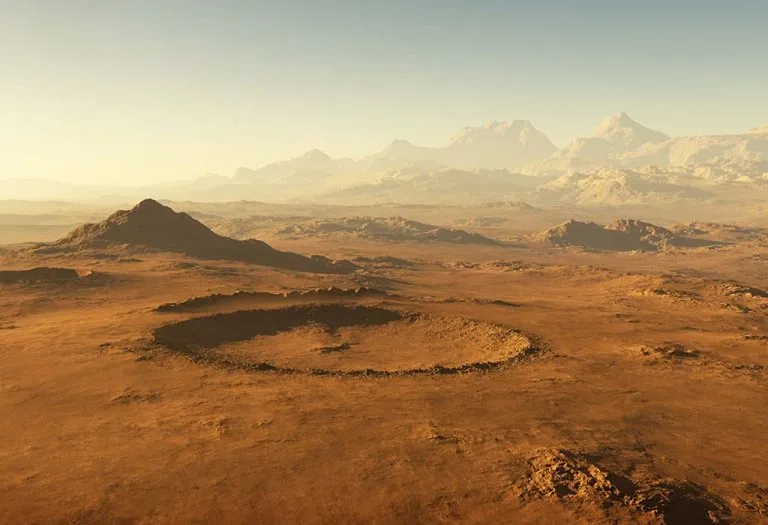Interesting Facts About Cheetahs For Kids
- Where Do Cheetahs Live and What Do They Look Like?
- How Long Do They Live?
- What Are the Different Types of Cheetahs?
- How Much Weight Does a Cheetah Have?
- Where Does Cheetah Sleep and How Many Hours Do They Sleep?
- How Many Cheetahs Are Now Left in the World?
- Information About Cheetah for Children
Kids are often fascinated with wild animals, and the cheetah is one such animal that may ignite the fire of inquisitiveness amongst young kids! Supporting a slender and slim body, this feline is built for speed and believe us, it is just a fraction of the information on this big cat! Well, if you wish to enlighten your kids about this magnificent animal with some fascinating facts about it, this post will help you do that and more! We have dug up some super exciting cheetah facts for kids. Browse to have a peek into some of the interesting and fun facts about this speedy animal!
Where Do Cheetahs Live and What Do They Look Like?
Cheetahs are amazing animals known for being the fastest land animals in the world. They live in Africa and can be found in various habitats, from grasslands to savannas to deserts. Cheetahs have beautiful golden coats covered in black spots.
Did you know that each cheetah has a unique pattern of spots, just like our fingerprints? Yes, they also have a long tail that helps them balance when they are running. Their slender and sleek body and long legs that allow them to take huge strides while running are perfect for capturing speed in no time. Cheetahs also have sharp claws that help them grip the ground while running at lightning-fast speed.
One of the coolest things about cheetahs is their faces. They have black tear-like markings under their eyes, which are thought to help protect their eyes from the sun and to help them see better when they are hunting. Nonetheless, they look adorable with all of these magnificent features.
How Long Do They Live?
Cheetahs are known to live for around 10 to 12 years in the wild. However, they can live up to 17 years or more in captivity. Like all animals, the life span of cheetahs can be influenced by a variety of factors, such as:
- Genetics,
- Environment, and
- Access to resources, such as food and water.
Additionally, cheetahs face several threats in the wild, such as:
- Habitat loss and
- Poaching, which can impact their survival and longevity.
What Are the Different Types of Cheetahs?
Did you know cheetahs are like your favourite cartoon characters with different costumes? That’s right, there are different types of cheetahs with unique patterns on their coats, just like superheroes have different costumes. Let us learn about some of them:
1. King Cheetah
The first species on our list is the king cheetah, primarily found in Africa. What sets this type of cheetah apart is its distinctive coat pattern, with broader and darker stripes on its fur that give it a majestic appearance. It is often considered the most regal of all cheetahs.
2. Asiatic Cheetah
The Asiatic cheetah inhabits a different region of the world than its African counterparts. This cheetah has a lighter coat than the African cheetah and a smaller body size, setting it apart from the other cheetah types.
3. Tanzanian Cheetah
The Tanzanian cheetah has a slightly longer coat and a lighter colouration than other cheetahs. This adaptation enables it to blend in more effectively within its surroundings and approach prey with greater stealth.
4. Regular African Cheetah
This is the most common type. It has a beautiful golden coat with black spots, just like the classic cheetahs you see in pictures and cartoons.
5. Iranian-Afghan Cheetah
The Iranian cheetah is a critically endangered subspecies of cheetah, indigenous to Iran and certain parts of Afghanistan. This cheetah type is smaller than its African counterpart and has an even tighter coat than the Asiatic cheetah. Shockingly, there are currently believed to be less than 50 Iranian cheetahs remaining in the wild, making them one of the most scarce and endangered big cats in the world.
So your favourite cheetahs come in different styles and colours, like superheroes or Disney princesses. Each type of cheetah is unique and special in its own way, making the world a more interesting and diverse place.
How Much Weight Does a Cheetah Have?
Adult cheetahs can weigh between 80 to 140 pounds (36 to 64 kilograms). That’s about the weight of two to three grown-up people! Male cheetahs are usually heavier than females. Just like people, cheetahs come in different shapes and sizes, so their weight can vary.
Where Does Cheetah Sleep and How Many Hours Do They Sleep?
Cheetahs sleep in different places depending on what’s around them. Sometimes, they sleep under trees or in tall grass, and other times, they might sleep on a rock or a hill where they can keep an eye on everything around them.
Cheetahs need a lot of sleep. Adult cheetahs usually sleep around 12 to 16 hours a day – that’s half a day! Surprisingly, young cheetah cubs can sleep up to 18 hours a day because they need lots of rest to grow and become big and strong.
How Many Cheetahs Are Now Left in the World?
Cheetahs are like the rockstars of the animal kingdom, with their lightning-fast speed and cool-looking fur. But did you know that these amazing animals are also endangered? Yes, only around 7,000 cheetahs are left in the wild, which is less than the number of people who can fit in an amusement park!
One of the reasons why cheetahs are endangered is because their habitats are being destroyed. This is similar to when a kid’s favourite park is turned into a parking lot. Humans are cutting down trees and building houses where cheetahs used to roam freely. Also, some people think cheetahs would make awesome pets, but this is not a humanitarian approach because they are wild animals and they do not belong in their natural habitats.
Thanks to wildlife sanctuaries and animal activists working around the clock to help protect cheetahs. They are creating safe areas where cheetahs can live and thrive and educating people about why protecting these amazing animals is important. So, let’s all do our part to help cheetahs and make sure they can continue to rock our world for years to come!
Information About Cheetah for Children
Just like lions, tigers or leopards, cheetahs also belong to the big cat family. However, unlike their other feline buddies, they aren’t that big in size. But don’t be fooled by its size, as this stunning animal is the fastest-living mammal on our planet. If you are intrigued and wish to gather more cheetah information for kids, well, here are some more facts and information on this beauty!
1. Cheetahs Are From The Cat Family
Well, that may not be a surprise for a lot of you because no matter how ferocious these big cats are, they look adorable, just like house cats and rightly so because they belong to the cat family. Most of the time, people mistake them for leopards, but unlike leopards, cheetahs have long black lines from their eyes to their mouths, known as tears, and they also have more rounded spots in comparison to leopards.
2. Cheetahs Are Super Fast
With its long legs, elongated spine, long tail, and adapted claws, the cheetah’s body is built for speed. Cheetahs are the fastest animals on our planet to reach a speed of 112 km/h in just a few seconds. Running at this lightning speed, a cheetah can also change direction or turn around mid-air.
3. Cheetahs Hunt During The Day
Cheetahs are efficient hunters, but unlike their fellow predators, such as leopards, lions, or hyenas, they hunt during the day to avoid any kind of competition. Their exceptional eyesight and speed help them to hunt their prey.
4. Cheetahs Usually Live in Groups
These big cats are mostly found in packs that comprise of mother and her cubs, siblings or a coalition of male cheetahs who stay together to hunt. However, female cheetahs often stay solitary and only meet their male counterparts for mating.
5. Cheetah’s Litter
The female cheetah gives birth to two to eight cubs in a single litter. The mother nurses the cubs, and the cubs stay with the mother for almost 16 to 24 months or until they are able to hunt for themselves. These cats have an average age span of 17 years; however, they can also live up to 20 years.
6. Cheetahs Are a Threatened Species
This magnificent animal is on the threshold of becoming endangered. There are approximately 7000 to 12000 cheetahs left in the world with the major numbers confined to South-Western Africa and Iran, however, at one point in time these big cats were found across Africa, Asia, and some parts of Middle East. The decrease in numbers is because of the loss of food sources and the loss of habitat for these big cats.
7. Cheetahs Are Not Aggressive
Though they hunt other animals, such as Impala, Wildebeest, Gazelles, etc., for food, these creatures are not naturally aggressive. If they are approached by a more aggressive or larger animal, they will avoid any fight and even may give up their prey.
8. Cheetahs Don’t Roar
The roar of any big cat is enough to scare anyone. However, cheetahs don’t roar! It may come as a surprise to many, but these animals let out chirping noises if they feel threatened, and they make a purring sound when they are happy.

9. Cheetah’s Spots
Have you ever wondered how many spots are there on a cheetah’s body? Well, a fully grown cheetah can have anywhere from 2000 to 3000 spots on its body, and every cheetah has a different pattern of spots, which lends uniqueness to each one of them. The spotted pattern also helps them to camouflage well while hunting.
10. Cheetahs Are Able Hunters
Their lightning-fast speed and sharp vision make them adept hunters. Their fur helps them blend and camouflage well in the surroundings before they pounce on their prey.
11. Cheetahs Were Kept as Pets
It may give you jitters to have this feline as a pet; however, many people had them as pets in the 50s and 60s. Phyllis Gordon, an American actress, and Greta Thyssen, a Danish actress, are among some of the renowned people who had cheetahs as pets. However, having this feline as a pet in many countries is illegal.
12. Cheetah’s Natural Habitat
If you want information about cheetah habitats for kids, well, these big cats are usually found in open grasslands and can also be seen in dense woodlands.
13. Cheetah’s Prey
Cheetahs usually hunt smaller prey such as hares, impalas, gazelles, etc. However, when they hunt in groups, they can hunt bigger animals, such as wildebeest and zebras. They are known for not stalking their prey. Rather they slowly creep up close to their prey before they pounce on it or chase it for a duration of only 20 to 30 seconds.
14. Cheetah’s Tail
A cheetah’s long tail, which can be around 60 to 80 centimetres in length, does more than add beauty to its demeanour. The big cat uses its tail to steer and balance while running after its prey. It actually helps the cat take sharp twists and turns while running.
15. Different Species of Cheetahs
There are approximately 36 species of cheetahs in the world. However, every species of cheetah derives its fluid requirement from its food, and they usually require water once in three to four days!
16. Cheetahs Have a Unique Anatomy
Cheetahs have long, slender bodies and long legs that help them run at high speeds. They also have a flexible spine and a long tail that helps them balance while running.
17. Cheetahs Are Sprinters, Not Long-Distance Runners
While cheetahs can run very fast, they can only maintain their top speed for short distances. After running at their top speed for a few hundred meters, they must rest and recover.
18. Cheetahs Can Accelerate Faster Than Most Sports Cars
Cheetahs can go from 0 to 60 miles per hour in just a few seconds, making them faster than most sports cars and racing bikes.
19. Cheetahs Have a Special Respiratory System
Cheetahs have enlarged nostrils and a large chest cavity, allowing them to take in more oxygen when running. This gives them an advantage when chasing prey, as they can sustain their high speeds for a short period of time.
20. Cheetahs Are Related to House Cats
Cheetahs are part of the Felidae family, which includes domestic cats, tigers, lions, and other big cats.
21. Cheetahs Have Been Trained to Hunt With Humans
People in some parts of the world have trained cheetahs to hunt alongside them for centuries. These cheetahs are known as “hunting cheetahs” and are used for hunting small animals, like hares. However, this practice is illegal in many parts of the world today, and cheetahs are protected by law.
22. Cheetahs Have a Unique Way of Having Babies
Female cheetahs need special help to have babies. They need a male cheetah to make their eggs grow so they can have baby cheetahs. Even when baby cheetahs are born, they have difficulty surviving because of genetic problems. This makes it hard for cheetahs to have many babies and grow their population. This is also one reason why they are endangered.
These are some astounding and amazing facts about this magnificent beast that you can share and with your kiddo! Telling your little ones about cheetahs will get them more interested in nature and wildlife and educate them about the importance of wildlife conservation.
Also Read:
Interesting Facts About Giraffes for Children
Horse Facts and Information for Kids
Fascinating Facts About Camel for Children
Amazing Facts About Sea Turtles for Kids
Was This Article Helpful?
Parenting is a huge responsibility, for you as a caregiver, but also for us as a parenting content platform. We understand that and take our responsibility of creating credible content seriously. FirstCry Parenting articles are written and published only after extensive research using factually sound references to deliver quality content that is accurate, validated by experts, and completely reliable. To understand how we go about creating content that is credible, read our editorial policy here.























